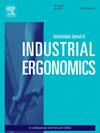基于虚拟现实的隧道黑洞对驾驶员心理压力及驾驶性能影响研究
IF 3
2区 工程技术
Q2 ENGINEERING, INDUSTRIAL
International Journal of Industrial Ergonomics
Pub Date : 2025-07-29
DOI:10.1016/j.ergon.2025.103791
引用次数: 0
摘要
这种现象被称为“黑洞效应”,发生在隧道入口处,是一种严重的视觉错觉,由照度、空间和参考的戏剧性变化引起。以往对隧道行车安全的研究主要是在真实隧道中进行的,难以隔离不同隧道照明环境对行车安全的影响,也难以准确测量驾驶员的速度和距离估计。因此,在这项工作中,我们引入了一个具有一致照明的虚拟隧道模型,并引入了三种场景:进入隧道(T1)、隧道外(T2)和开放道路(Base)。本研究采用接触时间(time-to-contact, TTC)范式,比较了30名司机在三种情景下自我速度和动态距离的变化,以研究空间转换的影响。线性混合模型分析表明,在T1情景下,空间转换导致驾驶员显著高估自身速度和低估TTC,并导致显著的瞳孔扩张。然而,T2的结果在距离和速度估计上与基础结果没有显著差异,但瞳孔直径明显增加。本实验结果支持隧道引入空间转换的假设,直接影响自我速度和动态距离估计,隧道在进入视野后立即引起驾驶员应力。本文章由计算机程序翻译,如有差异,请以英文原文为准。
A virtual reality-based study on tunnel black hole effects on drivers' psychological stress and driving performance
The phenomenon known as the "black hole effect," which occurs at tunnel entrances, is a severe visual illusion induced by dramatic transitions in illuminance, space and reference. Previous studies on tunnel driving safety have been conducted mainly in real tunnels, making it difficult to isolate the effects of different tunnel lighting environments on driving safety and to accurately measure drivers' speed and distance estimations. Therefore, in this work, we introduce a virtual tunnel model with consistent lighting and introduce three scenarios: entering the tunnel (T1), outside the tunnel (T2), and open road (Base). We compared changes in ego speed and dynamic distance estimates for 30 drivers across the three scenarios using the time-to-contact (TTC) paradigm to investigate the effects of spatial transitions. Linear mixed model analyses revealed that spatial transitions caused drivers to significantly overestimate their own speed and underestimate the TTC and caused significant pupil dilation in the T1 scenario. However, results for T2 did not show significant differences in distance or speed estimation from the base results, but the pupil diameter increased significantly. The results of this experiment support the hypothesis that tunnels introduce spatial transitions that directly affect the ego speed and dynamic distance estimation and that tunnels induce driver stress immediately upon entry into the visual field.
求助全文
通过发布文献求助,成功后即可免费获取论文全文。
去求助
来源期刊
CiteScore
6.40
自引率
12.90%
发文量
110
审稿时长
56 days
期刊介绍:
The journal publishes original contributions that add to our understanding of the role of humans in today systems and the interactions thereof with various system components. The journal typically covers the following areas: industrial and occupational ergonomics, design of systems, tools and equipment, human performance measurement and modeling, human productivity, humans in technologically complex systems, and safety. The focus of the articles includes basic theoretical advances, applications, case studies, new methodologies and procedures; and empirical studies.

 求助内容:
求助内容: 应助结果提醒方式:
应助结果提醒方式:


